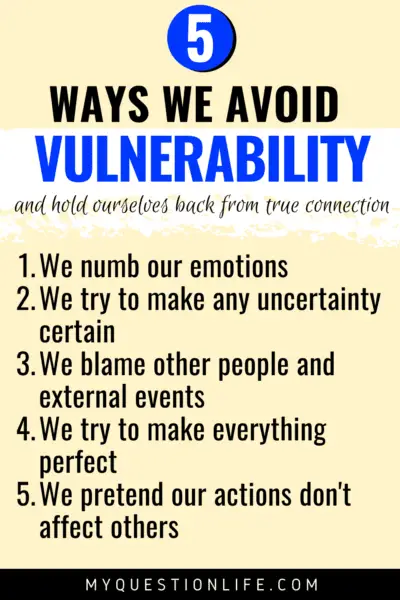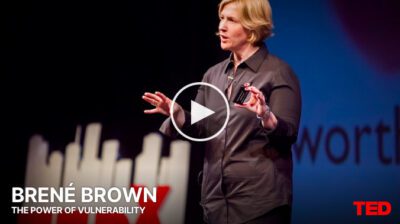The Power of Vulnerability: Life-Changing Lessons from Brené Brown
In 2010, Brené Brown didn’t expect her first Ted Talk, The Power of Vulnerability, to become a viral sensation. She also probably couldn’t have predicted the enormous popularity and success she would gain in the coming decade, including six published books and bestseller status.
Brené Brown is considered the leading expert on shame, vulnerability, courage, and empathy. She’s dedicated years to researching these topics and collecting groundbreaking data.
A decade later, her first talk on The Power of Vulnerability doesn’t just stand the test of time. It serves as the foundation for everything that came after it. As such, it still has valuable lessons for us to learn – including five ways we avoid vulnerability, and three things we can do to be more vulnerable in our lives.
.
What does the Power of Vulnerability mean?
When Brené Brown refers to vulnerability as a power, she means just that. In her video, she starts by explaining the importance of connection. As a social worker for ten years, she says, “You begin to realize that connection is why we’re here. It’s what gives meaning and purpose to our lives.”
But if connection is so vital to our well-being, then why do so many of us struggle with it?
As she dove into her research on connection, Brown began to notice two different groups of people emerge. The first group, who struggled with disconnection, had a deep sense of shame. They didn’t believe they were worthy of connection.
The second group, on the other hand, had an inherent sense of worthiness. When Brown looked at what these wholehearted people had in common, she found that their lives contained courage, compassion, authentic connection, and vulnerability.
.
Vulnerability is our ability to let our true selves be seen.
According to Brené Brown, wholehearted people “didn’t talk about vulnerability being comfortable or excruciating, but necessary.” Being vulnerable means choosing to show up as our true selves, even if we’re not sure of the outcome.
In The Power of Vulnerability, Brown cites these as examples of vulnerability:
- Saying “I love you” first
- Investing in a relationship that may or may not work out
- Doing something where they are no guarantees
Other vulnerability examples include doing something you’re not good at, allowing yourself to care, trusting someone, speaking your truth, and breaking the status quo.
Brown says, “Vulnerability is the birthplace of joy, creativity, belonging, and love.” Not only is there an enormous power of vulnerability, but it is fundamental for a meaningful life. There are many benefits to being vulnerable.
Read a more in-depth explanation of what vulnerability examples look like and how to be more vulnerable in your everyday life.
.
5 Ways We Avoid Vulnerability
Being vulnerable is not easy. While some people can “realize the importance of vulnerability and tenderness and walk into it,” most of us don’t find it that easy. Brené Brown refers to her struggle to be more vulnerable as a “street fight.”
In The Power of Vulnerability, Brown explains five ways in which we avoid vulnerability and hold ourselves back from connection:

1. We numb our emotions
Rather than feel negative emotions, many of us choose to numb ourselves to these strong feelings. We take the edge off through whatever means necessary. Some of us numb with alcohol, drugs, or medication; others numb with work, exercise, or perfectionism. Whatever we do, we’re numbing vulnerability.
In her talk, Brown explains, “The problem is that you can not selectively numb emotion. You can’t say, ‘Here’s the bad stuff – here’s vulnerability, grief, shame, fear, disappointment – and I don’t want to feel these.’ You can’t numb those hard feelings without numbing the other emotions. When we numb those, we numb joy, gratitude, happiness.”
.
2. We make uncertainty certain
It’s vulnerable to live in uncertainty, and it’s vulnerable to be wrong. As a result, we avoid vulnerability by trying to make things certain. We like to cling to absolute beliefs, even if it’s at the cost of our genuine connection and happiness.
Brené Brown describes this as “I’m right, you’re wrong, shut up” mentality. She gives politics and religion as two examples of where we avoid vulnerability. Because we’re forcing certainty, we take away our ability to connect, have discourse, and engage in positive conversation.
.
3. We blame other people and external events
The research defines blame as “a way to discharge pain and discomfort.” It can feel comfortable to blame any number of external factors – other people, specific events, the state of the world – for our problems.
When we do this, though, we prevent ourselves from accessing the lessons and truth we need to grow. We limit our self-awareness by refusing to ask ourselves the hard questions. It’s only through the power of vulnerability that we’ll be able to put in the work to accept ourselves as worthy, even with our flaws and mistakes.
.
4. We try to make everything perfect
Another way we avoid vulnerability is through perfectionism. Rather than embrace our imperfections, we try to put on a mask for the rest of the world. We shove our struggles down and strive to make our lives as perfect as possible.
Perfection, however, is merely another means of not accepting ourselves. When we strive to perfect our lives, we buy into the notion that we’ll be good enough after we perfect certain things. Wholehearted people understand that they are worthy just as they are.
.
5. We pretend our actions don’t affect others
Finally, Brené Brown says how many of us pretend that “what we do doesn’t have an effect on other people.” She explains that we do this in our personal and professional lives. Rather than be vulnerable and accept responsibly, we distance ourselves from our impact as a means of self-defense.
This distance takes away our feeling of connectedness to the people and world around us. What’s more, it can have devastating consequences for the people whom our actions affect. A much better option would be to be authentic, acknowledge our impact, and fix mistakes when necessary.
.
Life-Changing Lessons to Be More Vulnerable
Fortunately, Brené Brown doesn’t leave us without hope in The Power of Vulnerability. She ends her talk by giving us three practices that we can do to live more vulnerable lives.
She doesn’t claim them to be easy, nor does she describe them as immediate fixes. However, with proper motivation and understanding, we can work our way to more vulnerable lives.
-
Let ourselves be seen
To become wholehearted, we need to let ourselves be “deeply seen, vulnerably seen.” Only when we put our true selves out in the world can we feel the real sense of belonging we need to be happy. This means loving with our whole hearts, even if there’s no guarantee. It also means putting in the work for your own self-discovery journey.
-
Practice gratitude and joy
Even in moments of terror and uncertainty, we need to stop catastrophizing and say, “I’m just so grateful because to feel this vulnerable means I’m alive.” Gratitude and joy bring meaning and purpose to our lives. The more we can focus our attention on these emotions – and really let ourselves feel them – the more we can set ourselves up for happiness and connection.
-
Believe that we’re enough
Brown says that this practice is the most important, albeit perhaps the most difficult. We need to believe that we’re enough. when we work from a place of ‘I’m enough,’ we “can stop screaming and start listening, we’re kinder and gentler to the people around us, and we’re kinder and gentler to ourselves.”
.
You Need to Be Self-Aware to Be More Vulnerable
Which of the avoidance strategies are you falling back on? Are you implementing Brené Brown’s lessons in your life? How can you be sure?
To be vulnerable, you need to be self-aware – and self-awareness isn’t easy. Self-awareness is our ability to identity and monitor our thoughts, actions, and feelings. Take this free self-awareness test to see how self-aware you are. You also can learn more about why self-awareness and vulnerability are necessary together for self-growth.
.
Conclusion
The Power of Vulnerability transformed the way our society looked at vulnerability and shame. It also skyrocketed Brené Brown into the influential, positive figure that she is now. However, even ten years later, her first major talk still holds invaluable lessons for us.
Vulnerability is our ability to take emotional risks, even if we don’t know the outcome. It requires us to let our true selves be seen. While this can be terrifying, it’s necessary for a genuine, meaningful life.
In her talk, Brené Brown explains five ways that we avoid vulnerability and hold ourselves back from connection:
- We numb our emotions
- We make uncertainty certain
- We blame
- We perfect
- We pretend
She also explains three practices we need to do to live more vulnerable lives:
- Let ourselves be seen
- Practice gratitude and joy
- Believe that we’re enough
If you’re interested in learning more about vulnerability, check out Brené Brown’s books below. You can also subscribe to my newsletter and join the growing community of My Question Life followers who want to reclaim their life, become more self-aware, and learn how to be vulnerable. I don’t have all the answers you need, but I do have the ideas and questions to help you find them.
.





